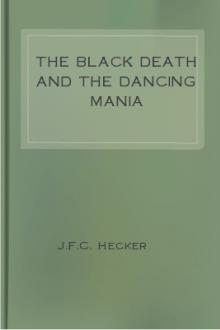The Black Death and The Dancing Mania, J. F. C. Hecker [digital ebook reader .TXT] 📗

- Author: J. F. C. Hecker
- Performer: -
Book online «The Black Death and The Dancing Mania, J. F. C. Hecker [digital ebook reader .TXT] 📗». Author J. F. C. Hecker
The first lazarettos were established upon islands at some distance from the city, seemingly as early as the year 1485. Here all strangers coming from places where the existence of plague was suspected were detained. If it appeared in the city itself, the sick were despatched with their families to what was called the Old Lazaretto, were there furnished with provisions and medicines, and when they were cured, were detained, together with all those who had had intercourse with them, still forty days longer in the New Lazaretto, situated on another island. All these regulations were every year improved, and their needful rigour was increased, so that from the year 1585 onwards, no appeal was allowed from the sentence of the Council of Health; and the other commercial nations gradually came to the support of the Venetians, by adopting corresponding regulations. Bills of health, however, were not general until the year 1665.
The appointment of a forty days’ detention, whence quarantines derive their name, was not dictated by caprice, but probably had a medical origin, which is derivable in part from the doctrine of critical days; for the fortieth day, according to the most ancient notions, has been always regarded as the last of ardent diseases, and the limit of separation between these and those which are chronic. It was the custom to subject lying-in women for forty days to a more exact superintendence. There was a good deal also said in medical works of forty-day epochs in the formation of the foetus, not to mention that the alchemists expected more durable revolutions in forty days, which period they called the philosophical month.
This period being generally held to prevail in natural processes, it appeared reasonable to assume, and legally to establish it, as that required for the development of latent principles of contagion, since public regulations cannot dispense with decisions of this kind, even though they should not be wholly justified by the nature of the case. Great stress has likewise been laid on theological and legal grounds, which were certainly of greater weight in the fifteenth century than in the modern times.
On this matter, however, we cannot decide, since our only object here is to point out the origin of a political means of protection against a disease which has been the greatest impediment to civilisation within the memory of man; a means that, like Jenner’s vaccine, after the small-pox had ravaged Europe for twelve hundred years, has diminished the check which mortality puts on the progress of civilisation, and thus given to the life and manners of the nations of this part of the world a new direction, the result of which we cannot foretell.
THE DANCING MANIA
CHAPTER I—THE DANCING MANIA IN GERMANY AND THE NETHERLANDS
SECT. 1—ST. JOHN’S DANCE
The effects of the Black Death had not yet subsided, and the graves of millions of its victims were scarcely closed, when a strange delusion arose in Germany, which took possession of the minds of men, and, in spite of the divinity of our nature, hurried away body and soul into the magic circle of hellish superstition.
It was a convulsion which in the most extraordinary manner infuriated the human frame, and excited the astonishment of contemporaries for more than two centuries, since which time it has never reappeared. It was called the dance of St. John or of St. Vitus, on account of the Bacchantic leaps by which it was characterised, and which gave to those affected, whilst performing their wild dance, and screaming and foaming with fury, all the appearance of persons possessed. It did not remain confined to particular localities, but was propagated by the sight of the sufferers, like a demoniacal epidemic, over the whole of Germany and the neighbouring countries to the north-west, which were already prepared for its reception by the prevailing opinions of the time.
So early as the year 1374, assemblages of men and women were seen at Aix-la-Chapelle, who had come out of Germany, and who, united by one common delusion, exhibited to the public both in the streets and in the churches the following strange spectacle. They formed circles hand in hand, and appearing to have lost all control over their senses, continued dancing, regardless of the bystanders, for hours together, in wild delirium, until at length they fell to the ground in a state of exhaustion. They then complained of extreme oppression, and groaned as if in the agonies of death, until they were swathed in cloths bound tightly round their waists, upon which they again recovered, and remained free from complaint until the next attack. This practice of swathing was resorted to on account of the tympany which followed these spasmodic ravings, but the bystanders frequently relieved patients in a less artificial manner, by thumping and trampling upon the parts affected. While dancing they neither saw nor heard, being insensible to external impressions through the senses, but were haunted by visions, their fancies conjuring up spirits whose names they shrieked out; and some of them afterwards asserted that they felt as if they had been immersed in a stream of blood, which obliged them to leap so high. Others, during the paroxysm, saw the heavens open and the Saviour enthroned with the Virgin Mary, according as the religious notions of the age were strangely and variously reflected in their imaginations.
Where the disease was completely developed, the attack commenced with epileptic convulsions. Those affected fell to the ground senseless, panting and labouring for breath. They foamed at the mouth, and suddenly springing up began their dance amidst strange contortions. Yet the malady doubtless made its appearance very variously, and was modified by temporary or local circumstances, whereof non-medical contemporaries but imperfectly noted the essential particulars, accustomed as they were to confound their observation of natural events with their notions of the world of spirits.
It was but a few months ere this demoniacal disease had spread from Aix-la-Chapelle, where it appeared in July, over the neighbouring Netherlands. In Liege, Utrecht, Tongres, and many other towns of Belgium, the dancers appeared with garlands in their hair, and their waists girt with cloths, that they might, as soon as the paroxysm was over, receive immediate relief on the attack of the tympany. This bandage was, by the insertion of a stick, easily twisted tight: many, however, obtained more relief from kicks and blows, which they found numbers of persons ready to administer: for, wherever the dancers appeared, the people assembled in crowds to gratify their curiosity with the frightful spectacle. At length the increasing number of the affected excited no less anxiety than the attention that was paid to them.
In towns and villages they took possession of the religious houses, processions were everywhere instituted on their account, and masses were said and hymns were sung, while the disease itself, of the demoniacal origin of which no one entertained the least doubt, excited everywhere astonishment and horror. In Liege the priests had recourse to exorcisms, and endeavoured by every means in their power to allay an evil which threatened so much danger to themselves; for the possessed assembling in multitudes, frequently poured forth imprecations against them, and menaced their destruction. They intimidated the people also to such a degree that there was an express ordinance issued that no one should make any but square-toed shoes, because these fanatics had manifested a morbid dislike to the pointed shoes which had come into fashion immediately after the “Great Mortality” in 1350.
They were still more irritated at the sight of red colours, the influence of which on the disordered nerves might lead us to imagine an extraordinary accordance between this spasmodic malady and the condition of infuriated animals; but in the St. John’s dancers this excitement was probably connected with apparitions consequent upon their convulsions. There were likewise some of them who were unable to endure the sight of persons weeping. The clergy seemed to become daily more and more confirmed in their belief that those who were affected were a kind of sectarians, and on this account they hastened their exorcisms as much as possible, in order that the evil might not spread amongst the higher classes, for hitherto scarcely any but the poor had been attacked, and the few people of respectability among the laity and clergy who were to be found among them, were persons whose natural frivolity was unable to withstand the excitement of novelty, even though it proceeded from a demoniacal influence. Some of the affected had indeed themselves declared, when under the influence of priestly forms of exorcism, that if the demons had been allowed only a few weeks’ more time, they would have entered the bodies of the nobility and princes, and through these have destroyed the clergy. Assertions of this sort, which those possessed uttered whilst in a state which may be compared with that of magnetic sleep, obtained general belief, and passed from mouth to mouth with wonderful additions. The priesthood were, on this account, so much the more zealous in their endeavours to anticipate every dangerous excitement of the people, as if the existing order of things could have been seriously threatened by such incoherent ravings. Their exertions were effectual, for exorcism was a powerful remedy in the fourteenth century; or it might perhaps be that this wild infatuation terminated in consequence of the exhaustion which naturally ensued from it; at all events, in the course of ten or eleven months the St. John’s dancers were no longer to be found in any of the cities of Belgium. The evil, however, was too deeply rooted to give way altogether to such feeble attacks.
A few months after this dancing malady had made its appearance at Aix-la-Chapelle, it broke out at Cologne, where the number of those possessed amounted to more than five hundred, and about the same time at Metz, the streets of which place are said to have been filled with eleven hundred dancers. Peasants left their ploughs, mechanics their workshops, housewives their domestic duties, to join the wild revels, and this rich commercial city became the scene of the most ruinous disorder. Secret desires were excited, and but too often found opportunities for wild enjoyment; and numerous beggars, stimulated by vice and misery, availed themselves of this new complaint to gain a temporary livelihood. Girls and boys quitted their parents, and servants their masters, to amuse themselves at the dances of those possessed, and greedily imbibed the poison of mental infection.
Above a hundred unmarried women were seen raving about in consecrated and unconsecrated places, and the consequences were soon perceived. Gangs of idle vagabonds, who understood how to imitate to the life the gestures and convulsions of those really affected, roved from place to place seeking maintenance and adventures, and thus, wherever they went, spreading this disgusting spasmodic disease like a plague; for in maladies of this kind the susceptible are infected as easily by the appearance as by the reality. At last it was found necessary to drive away these mischievous guests, who were equally inaccessible to the exorcisms of the priests and the remedies of the physicians. It was not, however, until after four months that the Rhenish cities were able to suppress these impostures, which had so alarmingly increased the original evil. In the meantime, when once called into existence, the plague crept on, and found abundant food in the tone of thought which prevailed in the fourteenth and fifteenth centuries, and even, though in a minor degree, throughout the sixteenth and seventeenth, causing a permanent disorder of the mind, and exhibiting in





Comments (0)